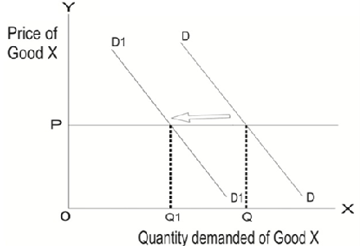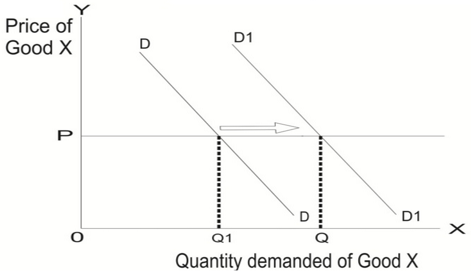
(a)
To explain:
The impact on
Answer to Problem 1CACQ
There will be fall in demand of goods X.
Explanation of Solution
There is a leftward shift in demand curve. This is because when there is decrease in income, it leads to fall in demand. This is because the commodity is normal goods. So, there is a positive relation between demand and income.
In the below diagram, DD is the initial demand curve and P is the

Figure 1: Decrease in the income of consume shifts demand curve leftwards
Thus, when income of the consumer decreases, the demand of goods X decreases from Q to Q1 keeping price of goods X fixed.
Normal Goods:
The goods are said to be a normal goods when there is a positive relation between income and demand of a commodity.
Inferior goods:
The goods are said to be inferior goods when there is an inverse relation between income and demand of a commodity.
(b)
To explain:
The impact on demand for goodsY due to increase in income.
Answer to Problem 1CACQ
There will be fall in demand of goodsY.
Explanation of Solution
There is a leftward shift in demand curve. This is because when there is increase in income, it leads to fall in demand as goods is an inferior goods. So, there is an inverse relation between demand and income, thus decreasing the demand of inferior goods.
In the below diagram, DD is the original demand curve, P is the initial price line. As income of a consumer increases, it leads to leftward shift of demand curve from DD to D1. This is because goods in question is an inferior goods.
Figure 2: Increase in the income of consumer shifts demand curve of Goods Y (Inferior Goods) leftwards

Thus, when income of the consumer increases, the demand of goods Y decreases from Q to Q1 keeping price of goods Y fixed.
Normal Goods:
The goods are said to be a normal goods when there is a positive relation between income and demand of a commodity.
Inferior goods:
The goods are said to be inferior goods when there is an inverse relation between income and demand of a commodity.
(c)
To explain:
The impact on demand for goods X due to increase in price of goods Y.
Answer to Problem 1CACQ
The demand for goods X increases when price of goods Y increases.
Explanation of Solution
It is given that the goods X and goods Y are substitute goods which mean that consumer can use these goods in place of one another. Substitute goods are those goods which are used in place of each other. Price of goods X leads to increase in demand for goods Y.
Goods are substitutable in nature. Demand of a goods is affected when price of related goods changes.
The diagram given below shows the effect of increase in the price of goods Y on the demand of goods X.
Figure 3: Demand curve of goods X shifts rightwards as price its substitute goods (Goods Y) increases.

In Figure-3, DD is the original demand curve, P is the price line. As there is an increase in price of goods Y, it leads to shift in demand curve from DD to D 1. Therefore, demand for goods X increases when price of goods Y increases.
Substitute goods:
Substitute goods are those which can be used in place of each other. These goods have a positive cross elasticity.
Complementary goods:
Complementary goods are those which are used together. These goods have negative cross elasticity.
(d)
To explain:
Whether goods Y is a lower quality product than goods X.
Answer to Problem 1CACQ
No, quality of goodsY cannot be determined.
Explanation of Solution
Inferior goods do not mean it is of sub-standard quality. The goods are said to be inferior in nature when the relationship between income of consumer and the demanded quantity of goods is indirect.
As income of consumer rises, it leads to decrease in demand of a commodity, this is because, consumer shifts its demand to a goods which is better than the goods consumed.
As income falls, it leads to increase in consumption of a goods. So, quality of goods Y cannot be determined.
Normal Goods:
The goods are said to be a normal goods when there is a positive relation between income and demand of a commodity.
Inferior goods:
The goods are said to be inferior goods when there is an inverse relation between income and demand of a commodity.
Want to see more full solutions like this?
Chapter 2 Solutions
Connect Access Card for Managerial Econnomics
- 19. In a paragraph, no bullet, points please answer the question and follow the instructions. Give only the solution: Use the Feynman technique throughout. Assume that you’re explaining the answer to someone who doesn’t know the topic at all. How does the Federal Reserve currently get the federal funds rate where they want it to be?arrow_forward18. In a paragraph, no bullet, points please answer the question and follow the instructions. Give only the solution: Use the Feynman technique throughout. Assume that you’re explaining the answer to someone who doesn’t know the topic at all. Carefully compare and contrast fiscal policy and monetary policy.arrow_forward15. In a paragraph, no bullet, points please answer the question and follow the instructions. Give only the solution: Use the Feynman technique throughout. Assume that you’re explaining the answer to someone who doesn’t know the topic at all. What are the common arguments for and against high levels of federal debt?arrow_forward
- 17. In a paragraph, no bullet, points please answer the question and follow the instructions. Give only the solution: Use the Feynman technique throughout. Assume that you’re explaining the answer to someone who doesn’t know the topic at all. Explain the difference between present value and future value. Be sure to use and explain the mathematical formulas for both. How does one interpret these formulas?arrow_forward12. Give the solution: Use the Feynman technique throughout. Assume that you’re explaining the answer to someone who doesn’t know the topic at all. Show and carefully explain the Taylor rule and all of its components, used as a monetary policy guide.arrow_forward20. In a paragraph, no bullet, points please answer the question and follow the instructions. Give only the solution: Use the Feynman technique throughout. Assume that you’re explaining the answer to someone who doesn’t know the topic at all. What is meant by the Federal Reserve’s new term “ample reserves”? What may be hidden in this new formulation by the Fed?arrow_forward
- 14. In a paragraph, no bullet, points please answer the question and follow the instructions. Give only the solution: Use the Feynman technique throughout. Assume that you’re explaining the answer to someone who doesn’t know the topic at all. What is the Keynesian view of fiscal policy and why are some economists skeptical?arrow_forward16. In a paragraph, no bullet, points please answer the question and follow the instructions. Give only the solution: Use the Feynman technique throughout. Assume that you’re explaining the answer to someone who doesn’t know the topic at all. Describe a bond or Treasury security. What are its components and what do they mean?arrow_forward13. In a paragraph, no bullet, points please answer the question and follow the instructions. Give only the solution: Use the Feynman technique throughout. Assume that you’re explaining the answer to someone who doesn’t know the topic at all. Where does the government get its funds that it spends? What is the difference between federal debt and federal deficit?arrow_forward
- 11. In a paragraph, no bullet, points please answer the question and follow the instructions. Give only the solution: Use the Feynman technique throughout. Assume that you’re explaining the answer to someone who doesn’t know the topic at all. Why is determining the precise interest rate target so difficult for the Fed?arrow_forwardProblem 1 Regression Discontinuity In the beginning of covid, the US government distributed covid stimulus payments. Suppose you are interested in the effect of receiving the full amount of the first stimulus payment on the total spending in dollars by single individuals in the month after receiving the payment. Single individuals with annual income below $75,00 received the full amount of the stimulus payment. You decide to use Regression Discontinuity to answer this question. The graph below shows the RD model. 3150 3100 3050 Total Spending in the month after receiving the stimulus payment 2950 3000 74000 74500 75000 75500 76000 Annual income a. What is the outcome? (5 points) b. What is the treatment? (5 points) C. What is the running variable? (5 points) d. What is the cutoff? (5 points) e. Who is in the treatment group and who is in the control group? (10 points) f. What is the discontinuity in the graph and how do you interpret it? (10 points) g. Explain a scenario which can…arrow_forwardProblem 2 Difference-in-Difference In the beginning of 2005, Minnesota increased the sales tax on alcohol. Suppose you are interested in studying the effect of the increase in sale taxes on alcohol on the number of car accidents due to drinking in Minnesota. Unlike Minnesota, Wisconsin did not change the sales tax on alcohol. You decide to use a Difference-in-difference (DID) Model. The numbers of car accidents in each state at the end of 2004 and 2005 are as follows: Year Number of car accidents in Minnesota Number of car accidents in Wisconsin 2004 2000 2500 2005 2500 3500 a. Which state is the treatment state and which state is the control state? (10 points) b. What is the change in the outcome for the treatment group between 2004 and 2005? (5 points) C. Can we interpret the change in the outcome for the treatment group between 2004 and 2005 as the causal effect of the policy on car accidents? Explain your answer. (10 points) d. What is the change in the outcome for the control…arrow_forward
 Economics (MindTap Course List)EconomicsISBN:9781337617383Author:Roger A. ArnoldPublisher:Cengage Learning
Economics (MindTap Course List)EconomicsISBN:9781337617383Author:Roger A. ArnoldPublisher:Cengage Learning









